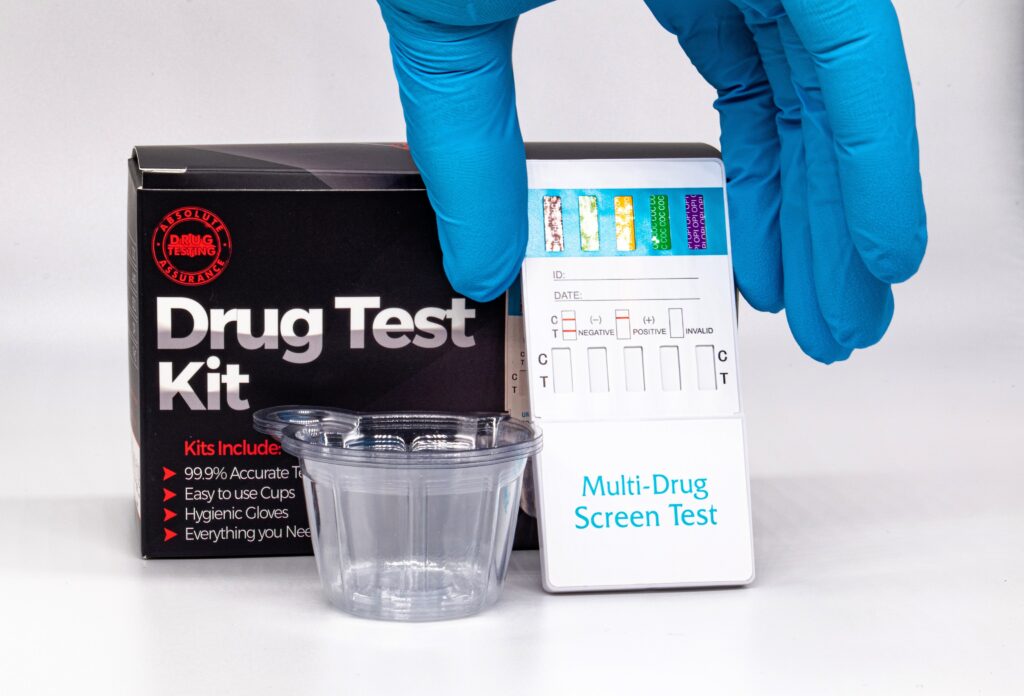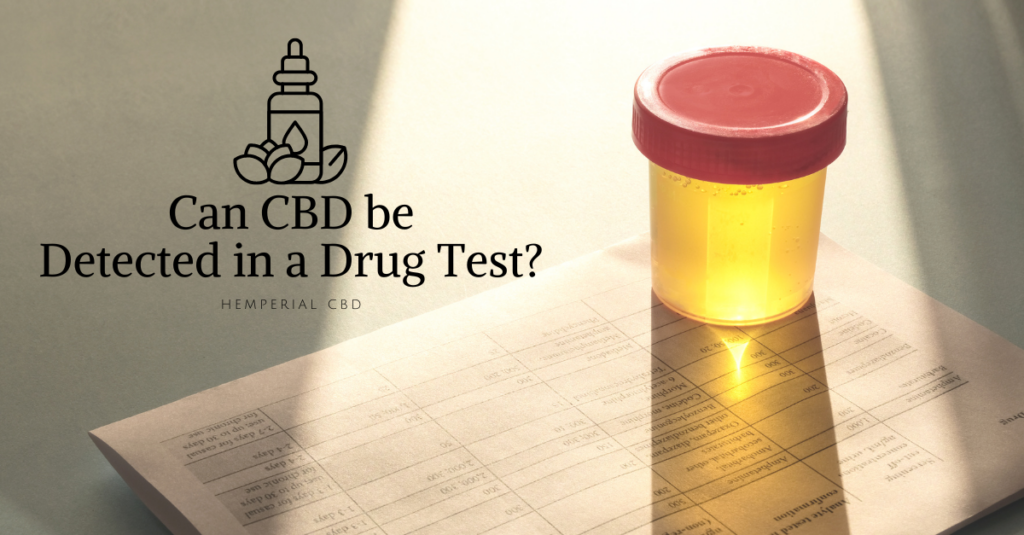Can CBD be detected in a drug test? This is one of the most common questions among CBD users. Have you ever viewed HBO’s Ballers? Vernon Littlefield, a coveted defensive end for the Dallas Cowboys, is given a four-game suspension in one of the season three storylines after testing positive for THC in a drug test.
Problematically, he had never smoked marijuana or experienced being high. Ever. All he did to relieve the pain following an Achilles tendon tear was eat CBD (in large amounts).
Even though this is a fictional TV drama, we are aware that people deal with situations like this every day. Therefore, we decided that discussing whether CBD appears on a drug test would be beneficial.
It shouldn’t appear in a typical urine test, but it occasionally does, is the short answer. Not yet clear? Fear not—we’ll explain.
How Is CBD Able to Test Positive on a Drug Test?

If you’ve spent any time in the CBD community, you probably already know that THC isn’t present in the majority of CBD products. Cannabis contains THC, and more precisely delta-9-tetrahydrocannabinol, which is what gives users a high.
On the other hand, many CBD products on the market contain traces of THC. You might have enough THC in your system to show up positive on a drug test if the product contains enough of it or if you’ve been using it frequently.
Additionally, a product must have less than 0.3% THC in order to be labeled as having hemp-derived CBD, however hemp isn’t always compliant with this requirement.
Plants do not adhere to rules.
For those who are unaware, hemp and marijuana are both members of the Cannabis Sativa plant family. Although they resemble one another almost exactly, hemp plants and marijuana plants differ significantly in that hemp plants have almost no THC.
CBD products made from hemp can’t contain more than 0.3% THC in order to be marketed as THC-free, but plants didn’t get the signal and often go their own way.
The amounts of CBD and THC in a plant might differ even within the same strain. In actuality, all 113 distinct cannabinoids can exist in varied amounts. According to the prevailing idea, they serve to shield the plant from UV rays. The cannabinoid profile can change according on light exposure.
Pollination is another aspect of the environment that may have an impact on the makeup of a hemp plant. When two plants that only produce CBD “hook up,” their progeny may end up producing THC.
At Hemperial CBD, we take measures to ensure that our goods correspond to what is said on the label. We employ cutting-edge supercritical CO2 extraction methods in a pharmaceutical-grade extraction procedure. This enables us to extract the cannabinoids from the plant without using solvents, producing an extremely pure product.
Key Lesson: High quantities of THC can be found in even “pure” CBD products. Consumers must conduct more research up till regulations are tougher about labeling and testing requirements, unless they choose Hemperial CBD. Third-party testing of all of our products is part of our stringent quality control process
A lack of testing
Speaking of testing, you might have accidentally and mistakenly ingested this material in quantities that would easily show up on a drug test if a crop was cross-contaminated and the product did not undergo batch testing to confirm THC levels.
The lesson of the story is to only purchase CBD products that have undergone rigorous testing to ensure that what is on the label is what you are ingesting.
Cross-Contamination
If CBD and THC come into contact with one another, they may cross-contaminate. This can occur both at home and throughout the production process. Cross-contamination may occur if CBD oil is around a THC-containing environment. Our product handling policies are as strict as our quality control because of this possibility. We take special precautions to make sure that there is no chance of cross-contamination at our labs.
Indirect exposure
Although it is unusual, it is possible for secondhand exposure to result in a positive test result. Make sure the area is sufficiently ventilated if you find yourself in a location where marijuana is being smoked. The size of the area and the airflow in the space affect the likelihood of a successful outcome.
Product Mislabeling
Because the CBD business is unregulated, manufacturers can act carelessly with little to no repercussions. Some businesses purposefully mislead consumers, while others simply don’t want to spend the additional money and time required to evaluate their products in a lab.
A concerning study from the Netherlands in 2017 assessed 84 items that were bought online and purported to contain just CBD. 18 of the 84 goods tested positive for THC, which is just another reason to do business with Hemperial CBD. As previously indicated, we employ stringent procedures to guarantee that our goods are precisely what we claim they are.
Some CBD products include THC.
One of the three kinds of CBD can contain THC, but never in concentrations greater than.3%.
- Full-spectrum – All of the naturally existing components in hemp, including perhaps THC, are retained in these extracts. THC content when extracted from marijuana plants will vary based on the specific plant. Legally, THC levels must be less than 0.3% when it comes from hemp, but this can only be established by an independent scientific test.
- Broad-spectrum – If you’re concerned that THC will cause you to fail a drug test, this kind of CBD is a good choice. THC has been removed from broad-spectrum CBD, leaving it completely absent in the finished product. This kind of CBD isn’t as generally accessible, though.
- CBD Isolate – There are no extra plant-derived components present in this CBD, making it pure. It should have no THC as long as the CBD isolate is made from a hemp plant. A THC-free CBD product is one of our CBD gummies.
The Threshold for THC
In Mayo Clinic Proceedings, a paper from 2017 acknowledged the severe repercussions that employees would experience if they were given a false positive result from a drug test for employment. There was an undercurrent that suggested the incidence of these false positives was caused by both an increase in the usage of drugs like CBD as well as more sophisticated screening methods and more sensitive detection systems.
To avoid rejecting applicants who had very small quantities of THC in their systems, cut-off values were developed. These cut-off criteria stop a drug test from returning positive if the THC level is below a predetermined level.
With this new criterion, you could be able to take a drug test even if you have a very small level of THC in your system. The cut-off numbers and detection windows will vary depending on the type of test.
How long does CBD last in the body?
Employers typically request a urine sample for drug testing, but other options include hair, blood, or saliva tests. There will be a distinct cut-off threshold for each of these tests. This distinction is crucial to understand because different testing procedures take different amounts of time to detect THC.
Urine
The THC discovered in your urine can be detected for an average of 13 days, with a range of three to 15 days, if you use marijuana occasionally. THC requires five to six half-lives to leave your system because its removal is measured in half-lives. According to this reasoning, a person who ingested THC just once can anticipate that it will leave their body in roughly five to eight days.
However, regular and heavy users can anticipate a significantly longer detection window, usually 30 days or more.
The cut-off level for THC testing in urine is 50 nanograms per milliliter. A nanogram is one billionth of a gram, so that helps put things into perspective.
Hair
THC can linger in your hair for up to a year, but the typical retention time is closer to 90 days. Hair tests are uncommon, and there are no set upper and lower limits. The norm in the private sector is typically one picogram per milligram (abbreviated as pg/mg). A picogram, which is one trillionth of a gram, is even smaller than a nanogram.
You won’t likely be able to get around a hair test if you have to take one. THC is fat-soluble, therefore detox shampoos that promise to remove it from hair are unreliable. This indicates that marijuana enters your system through fat, and that the THC metabolites in your blood are transferred to your hair through your skin oils.
The good news is that a positive test result might be able to be justified. They did discover that exposure to THC and its contact with the hair could have a beneficial effect. It may not be Mary Poppins-approved conduct to be among marijuana smokers, but it is not a reason to fail a drug test, especially if you didn’t inhale.
Another intriguing investigation was conducted in 2004. (again in Germany). According to this study, touching marijuana and then your hair can cause a positive drug test result. One of the study subjects had a couple living together who both tested positive for THC even though only one of them used the drug.
Blood
THC is not frequently utilized in workplace drug tests since it circulates fast through the blood. It is intended to identify present impairment instead. THC metabolites can be detectable for up to seven days even though THC itself only remains in the bloodstream for about five hours.
THC itself is not the same as a THC metabolite. The metabolite is a result of the primary medication as it is broken down by your body. Each person metabolizes THC at a different rate because processing this chemical is dependant on the metabolic process.
Saliva
THC is typically detectable in saliva for about 72 hours, but heavy, long-term users may retain it for longer.
There are no standardized THC cut-off levels for this kind of test, and saliva testing is not a common practice. 4 nanograms per milliliter (4 ng/mL) was suggested as the cutoff limit by the Journal of Medical Toxicology.
Take these precautions to prevent consuming a CBD product that contains THC.
- Read the Labels
- You can avoid accidentally ingesting THC by being aware of what to look for. To determine if the CBD is made from hemp or marijuana, look at the product label. Our entire line of items is made from premium hemp.
- Next, look for the CBD’s type. There are three types of CBD: isolate, broad-spectrum, and full-spectrum.
- Search for terms like CO2-extracted, solvent-free, lab-tested, pesticide-free, no additives, etc. on the label. You can determine the product’s quality by looking for these terms.
- Choose Your Products Wisely
- You can completely avoid this substance by sticking with goods that you are certain are THC-free. We suggest Hemperial CBD’s THC-free gummies if you want to consume CBD without worrying about failing a drug test. They’re a delectable way to receive your daily CBD dose without any THC.
